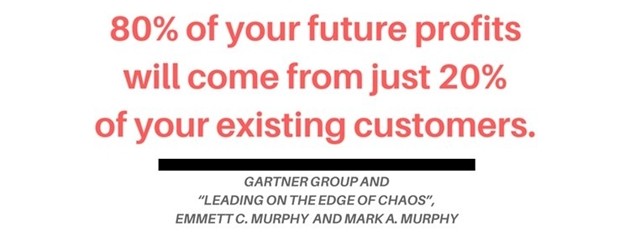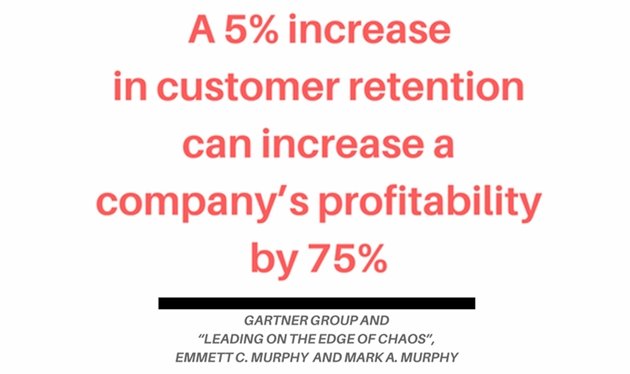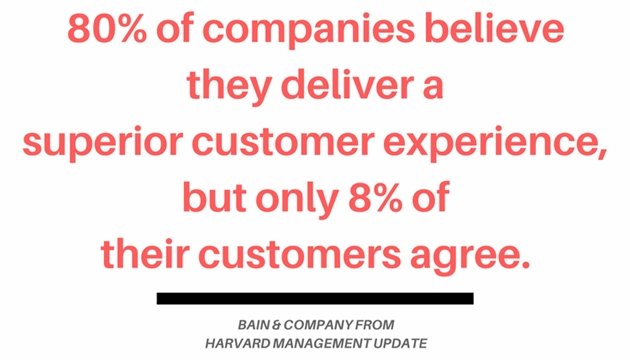For most companies, the cost of acquiring a new customer is far more than the cost of retaining an existing customer—often 5-10 times more expensive. Moreover, 61% of small business owners have reported that more than half of their annual revenue comes from repeat buyers.
Those impressive numbers confirm the 80/20 rule to be true (20% of customers bring 80% of the business); and, thanks to the substantial amount of customer data businesses now have available, many businesses are shifting their primary focus to these customers.
If a business is to retain current customers, then its marketers must truly understand repeat customers' needs to improve their overall experience with the brand and gain their long-term loyalty.

For most marketers, it is no longer a challenge to collect customer data: Analytical technologies have given us the tools to understand a customer's actions at every point of interaction with a brand. But many marketers are still struggling to transform that analytical data into relevant information that can help improve customer loyalty.
Fortunately, there are steps marketers can take to harness data science and keep churn rates at a minimum.
Companies have been using data science as a secret weapon to generate quickly actionable information that improves customer retention. If you're interested in significantly decreasing your customer churn rate, here's how to use the power of data science to define a process that will help your brand keep the customers you've already worked so hard to obtain.
Step 1: To identify churners, define your business model
Nowadays, subscription and recurring-revenue business models are everywhere. And no wonder: how customers want to access and pay for goods and services is changing, so companies are in turn changing their pricing models.
The first step in setting up a data-driven approach to increasing customer loyalty is to define the model used by your organization. More than likely, your model will fall under one of two varieties: a subscription model or a non-subscription model. (Netflix and Spotify are examples of a subscription model; Uber and eBay are examples of a non-subscription model.)
Your business model has an impact on the difficulty of determining "churn rate," which can have different definitions; however, for most businesses, it's a matter of whether a customer will become a "churner"—i.e., no longer a customer. Churn could also refer to the loss of contracts, MRR (monthly recurring revenue), contract value, and bookings.
Churn is frequently expressed as a rate, a ratio, or a whole number: for example, "We have a churn rate of 10%," and, "We churned five customers."
Identifying churners is straightforward in a subscription model: A customer churns when she requests a cancellation of her subscription. In a non-subscription model, however, you will need to analyze a customer's behavioral tendencies to identify possible churn—such as the amount of time since he or she last used your company's services. The primary goal is to determine the specific point after which your customer will no longer use your product or service.
Step 2: Decide on an approach to increase customer retention and reduce churn

Now that you've determined your business model, there are many ways you can start retaining potential churners with both short-term actions and a long-term approach. To have the most effective and sustainable impact on customer retention, you can try a combination of the following two methods.
1. One-shot, short-term actions
- Launch special offers in the form of calls, push notifications, free in-game money, discount coupons, etc.
- To control or measure customer satisfaction, set up customer feedback loops in the form of surveys, on-website or in-app questionnaires, self-service options such as designated review or feedback sections.
2. Longer-term approaches to attack the root of a problem
- Reduce obstacles to make it easier to purchase your product.
- Analyze whether your the offer fits your customer base.

Step 3: Create customer profiles (segments) and determine their behavior
What do you need to provide the right offer to your customers at the right moment (i.e., when they are making a purchasing decision)?
The answer: in-depth knowledge about that customer. However, too often customers avoid handing over personal information that can be useful to marketers—such as age, gender, profession, and buying habits. That's why a data-driven approach is an advantage.
Instead of asking customers for such information, it can be collected and assessed externally. The success of your business is directly linked to a true understanding of your customers, and a data science approach works only when you have a defined target. In a subscription business model, the target is known; however, if you're operating a non-subscription model, you will first need to define your target if you're going to understand it.
You can create a customer profile and identify behaviors by asking yourself (or your team) the following questions:
- Which customers do we care about? Segment your customers based on their behavior, and ask, "Which customers do we care most about?" Regardless of the answer, the only way to increase customer loyalty with this type of campaign is to target a well-defined customer segment.
- How will we segment new customers? By understanding the extremes of your customers, you can create and refine new customer segments. On one extreme, you will have customers who interacted with your brand at least once, but discontinued interaction afterward. The other extreme will include customers who use your product or service frequently or are heavily engaged with your brand.
Once you identify these extremes and understand your customer segmentations, it will be much easier to place a new customer in the appropriate grouping. - What makes our churner customers different? You will begin identifying patterns among your churners and define what makes them different fomr others. Make note of, and discuss, these differences frequently.
Step 4: Define and implement a customer-scoring process
Now that you've identified your target customers and understand their behaviors, you can implement a method of scoring your customers based on the data you have about them.
Customer traits, such as social information and behavior-based actions, can be used to paint a picture of who they are. Then, you can compute a score that incorporates all relevant customer features to determine exactly how likely that person is to abandon your offerings.
This is the point at which you can harness data science to take over. A predictive analytics platform can be used to aggregate all your customer data, identify potential churners, and calculate a score that predicts the potential retention of your customers.
This type of scoring system enables marketers to creatively segment customers and activate the most appropriate marketing strategies for each. For example, potential customer segments and actions for each could be laid out like this:
- Loyal customers: Take no action.
- Potential churners (customers you want to keep): Send a special offer via email.
- Churners: Send a special offer via email.
- Ambivalent (unsure whether to keep): Send a simple greeting without an offer.
* * *
When debating whether to spend money to attract new customers or to take care of the customers you already have, the answer is usually simple: The costs of acquiring a new customer far outweigh the costs of keeping one you already have.
Using the steps outlined above, you can arm your marketing team with the necessary data science and customer insights that will help your company not only identify and retain customers but also improve the customer experience overall.
More Resources on Customer Retention and Data Science
Five Steps to Winning Back Lost Customers by Using Targeted Content




